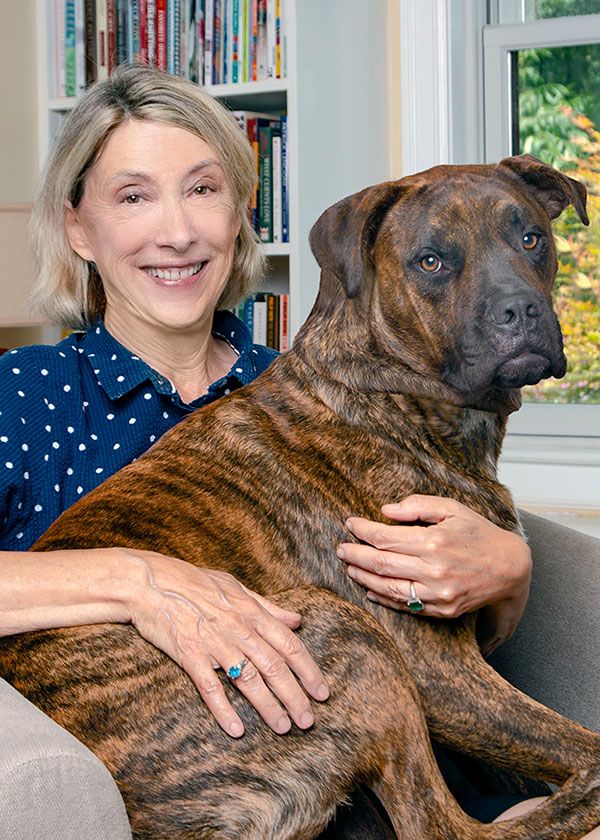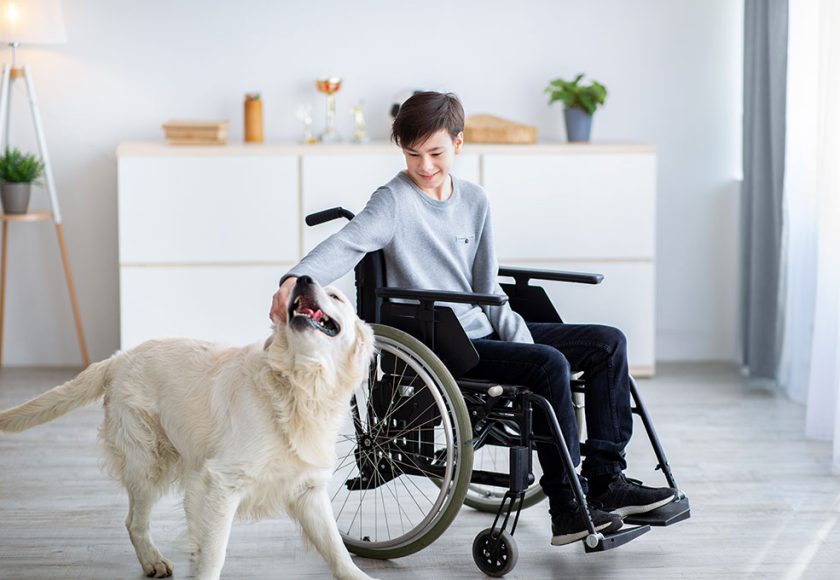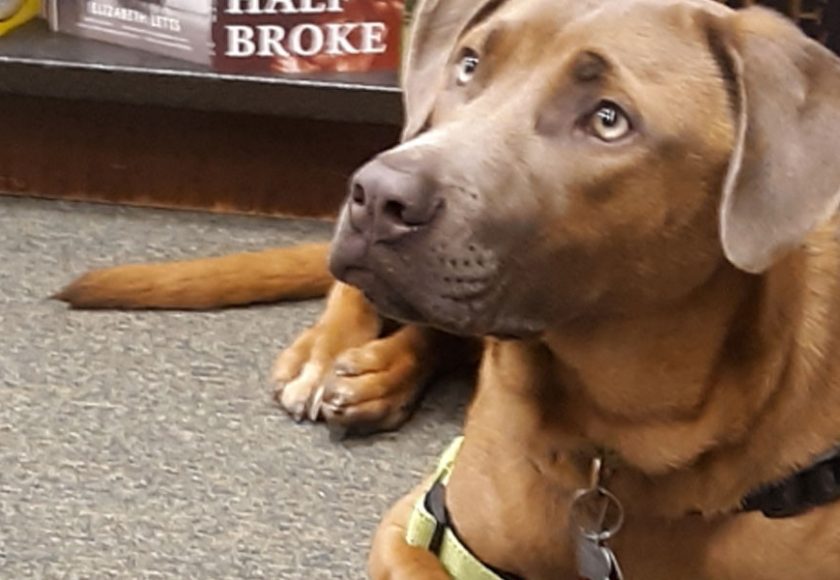Positive dog training is the foundation of raising well-mannered, confident service dogs. At Putnam Service Dogs, we require our volunteer puppy raisers to use positive reinforcement techniques—rewarding good behavior with treats, praise, and encouragement—while avoiding any and all forms of physical punishment or harsh corrections. By following structured guidelines and reinforcing desirable behaviors, our puppy raisers help shape service dogs that are not only obedient but also trusting, resilient, and eager to learn.
Why Positive Dog Training Is Essential for Raising Service Dog Pups
Also known as positive reinforcement, positive dog training is key to developing well-disciplined, confident service dogs. This approach not only teaches essential skills but also provides structure and predictability, helping dogs feel secure in their environment. Just as important, it fosters a strong bond between the dog and its handlers, ensuring a deep sense of trust and cooperation. By reinforcing good behavior rather than punishing mistakes, service dogs learn to navigate the world with calmness and reliability—making them better equipped to assist their future recipients.
What Is Positive Dog Training, or Positive Reinforcement?
Positive dog training is a reward-based approach that focuses on reinforcing good behavior first, most, early and often, rather than punishing mistakes. More than just a training method, it’s a philosophy built on trust, patience, and clear communication. By understanding a dog’s needs, creating a supportive environment, and consistently rewarding desired behaviors, positive training helps dogs develop the skills they need to thrive as well-behaved companions and working service dogs.
How Positive Reinforcement Works for Dogs
Positive reinforcement training is as simple as finding opportunities to offer praise throughout the day when dogs perform the desired behaviors. It also involves management, which may require the use of a leash, crate, gate, or tether, to prevent unwanted behaviors during the learning process. There are four keys to positive reinforcement for dogs:
- Appreciating the dog’s point of view
- Recognizing and meeting the dog’s needs
- Understanding and applying positive training
- Avoiding fear, physical punishment and intimidation
At Putnam Service Dogs, we are committed to training service dogs using positive reinforcement positive first, most, early and often because it is the most effective, humane, and ethical approach. Punishment-based methods can create fear, anxiety, and confusion, which hinder a dog’s ability to learn and trust their handler. Our goal is to raise confident, well-mannered service dogs who can perform their duties with reliability and enthusiasm. By using praise, rewards, and redirection instead of fear or intimidation, we build strong, trusting bonds between dogs and their handlers—setting them up for lifelong success in service.
The Role of Patience and Consistency in Positive Dog Training
A key reason Putnam Service Dogs relies exclusively on positive reinforcement is that it fosters trust, confidence, and long-term success. However, for this method to be truly effective, it must be paired with patience and consistency.
Like young children, puppies don’t instinctively know right from wrong—they learn through repetition and clear guidance. Volunteer puppy raisers play a crucial role in shaping a future service dog’s behavior by staying attentive, redirecting as needed, and reinforcing good habits throughout the day. Consistency is just as important as praise; looking for at least 20 opportunities each day to reward desired behaviors helps create a strong foundation for lifelong learning and service.
The Impact of Saying “Good Boy!” or “Good Girl!”
Saying, “Good boy!” or “Good girl!” is a form of praise. Consistently pairing this specific phrase with a reward early in training will teach your dog that he or she has done something you like, which is vital for bond-building and teaching proper behaviors. If you’ve ever watched our videos, you’ll hear how often Melissa Schiraldi, our trainer, reinforces good behavior with “Good Boy” or “Good Girl”. The more praise the dog receives, the more frequently he or she will perform the desired behavior.
Practical Tips to Engage in Positive Reinforcement for Dogs
Some of the best ways to implement positive dog training in your household include the following:
- Remember dogs don’t work for free. No matter the bond between a person and a pup, a dog does not enjoy working for free. If a treat or toy isn’t available, praising the dog is a valid form of payment that your pup will come to love.
- Determine what your dog likes. Some dogs are food motivated, but others find favorite toys more desirable. Find out which form of positive dog training works best for your pup, and gravitate toward that as often as possible.
- Teach your dog to expect rewards for good behavior. Whether that reward is food, praise, toys, or a coveted play session in the backyard, your dog will eventually come to learn that good behavior comes with a reward. Furthermore, your dog will perform those behaviors more often.
- Be consistent in the way you react. This is true for both desired and undesired behaviors. Consistency in the verbal cues, hand signals, and body language you use is equally important.
Help Us Raise Life-Changing Service Dogs
Positive dog training is a requirement with Putnam Service Dogs. Our expert team knows that positive reinforcement training is by far the best, most humane, and fastest way to help up-and-coming service dogs learn the right behaviors and traits. When you become a volunteer puppy raiser with Putnam Service Dogs, you help us in our mission to provide free service dogs to individuals with disabilities other than blindness and veterans. If you are unable to volunteer, but you want to join us on our mission, consider making a one-time or monthly donation, instead.
FAQ:
What is positive dog training or positive reinforcement for dogs?
Positive dog training is a reward-based approach that emphasizes reinforcing positive behaviors with rewards, along with proactive management, to minimize the need to correct unwanted behaviors. It helps build trust, confidence, and a strong bond between the dog and handler.
How does positive reinforcement work?
Positive reinforcement works by rewarding a dog immediately after they perform a desired behavior, encouraging them to repeat it. The reward can be food, verbal praise, toys, or reinforcing the connection between good behavior and positive outcomes.
When should a puppy raiser use positive reinforcement?
Puppy raisers should use positive reinforcement consistently throughout the day, rewarding good behavior as it happens. This includes training sessions, everyday interactions, and moments when the puppy naturally displays desired behaviors.
What are the best ways to reward dogs for good behavior?
The best rewards vary by dog but commonly include treats, verbal praise, petting, favorite toys, engaging play or socializing sessions, and encouragement. Finding what motivates the dog most helps reinforce positive behaviors effectively.
Will using treats encourage a dog to constantly beg for food?
No, when used correctly, treats are a training tool, not a bribe. By pairing treats with verbal praise and gradually varying their frequency, dogs learn to respond to commands without expecting food every time.
How can I use positive dog training to curb unwanted behaviors?
Redirect your dog to a desired behavior and reward them for making the right choice. Instead of punishing bad behavior, use management, consistency, patience, and positive reinforcement to encourage good habits while preventing unwanted actions.






